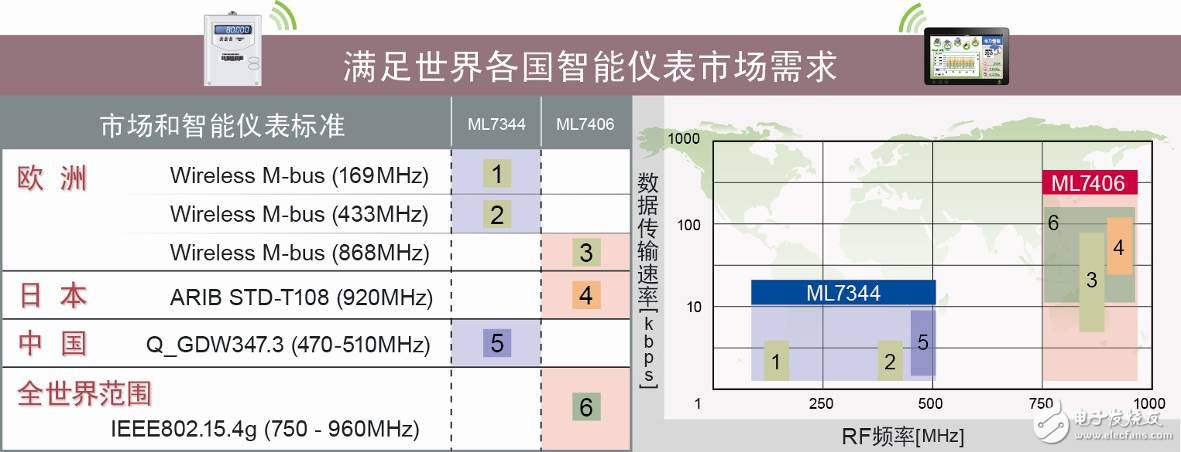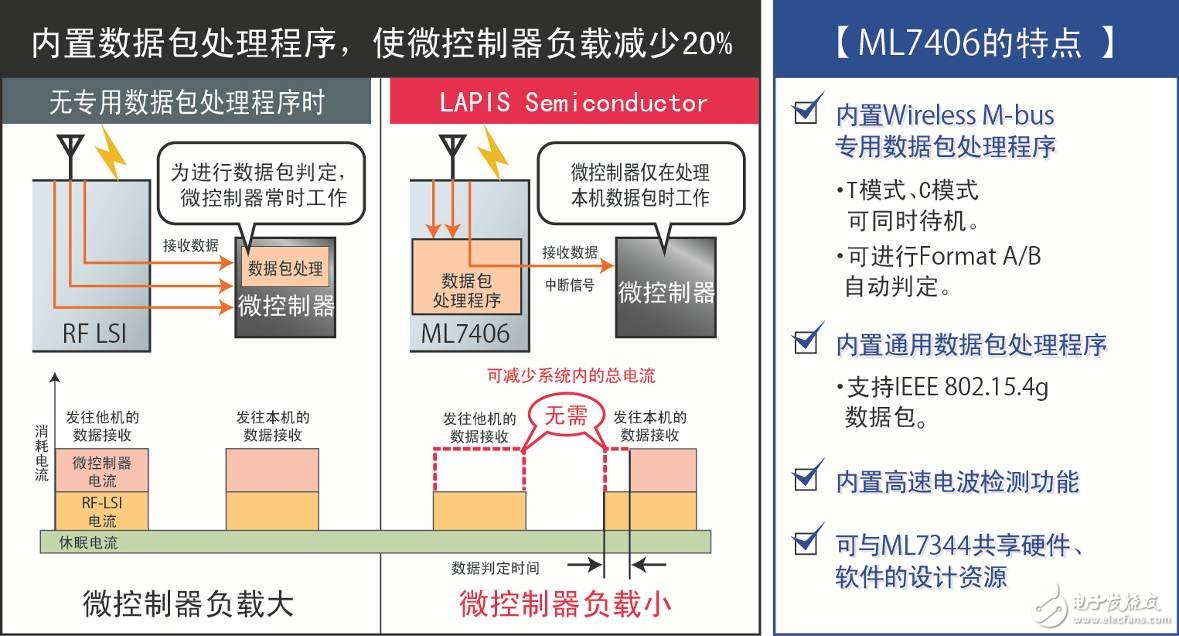LAPIS Semiconductor, a subsidiary of the ROHM Group, has developed a wireless communication LSI "ML7406" that conforms to the 868MHz European smart meter communication standard Wireless M-bus Note 1. The product is equipped with the signal processing function of each mode required by the Wireless M-bus standard according to the specification, thereby reducing the microcontroller load by about 20%, successfully reducing the overall power consumption of the device, and is very helpful for battery drive Long-term driving of similar smart meters and reduced maintenance.
In addition, LAPIS Semiconductor has developed the "ML7344E" that complies with the Wireless M-bus standard at 169MHz (N-Mode) and 433MHz (F-Mode). This time through the development of "ML7406" for 868MHz, ROHM has a lineup of products covering the entire frequency band of Wireless M-bus, which can meet the needs of smart meter markets in European countries.

Samples of this product have been sold since April, and mass production and sales are expected to begin in September. The production base for the early stage is LAPIS Semiconductor Miyagi Co., Ltd. (Miyagi Prefecture, Japan), and the production base for the later stage is LAPIS Semiconductor Miyazaki Co., Ltd. (Miyazaki Prefecture, Japan).

In addition, "ML7406" is suitable for the 750MHz ~ 960MHz frequency band, not only conforms to the ARIB STD-T108 Note 2 standard in Japan, but also conforms to the world standard IEEE802.15.4g. EMS) and other broad fields.

In recent years, countries around the world have begun to work on the development of smart meters. In Europe, it is generally believed that the Wireless M-bus method will become the mainstream data communication method. The Wireless M-bus in the 868MHz band, which is expected to be popularized in Germany and its neighboring countries, has three modes. It is necessary to distinguish signals according to different modes according to the operation mode. Traditionally, the software on the microcontroller side performs packet processing to discern patterns and information, which puts a heavy load on the microcontroller and leads to increased power consumption.
LAPIS Semiconductor is a major member of the OMS (Open Metering System) Note 3 protocol development working on Wireless M-bus. In addition, Steinbeis, a large supplier of the protocol, has jointly developed product specifications related to the hardware processing of packet processing. Therefore, the Wireless M-bus packet processing program is built into this LSI. The Wireless M-bus packet processing program can handle the simultaneous standby function of C mode and T mode through hardware, the automatic discrimination function of Format-A and Format-B information in C mode, and automatically determine whether the local packet or other data Packet address filtering function, etc. Through these efforts, the operating rate of the microcontroller can be reduced by about 20% compared with the previous system that is processed by software, which is very helpful to reduce the power consumption of the device.
Not only that, the protocol stack for Wireless M-bus can provide sample software and C source code with built-in T-mode, C-mode, and S-mode functions that comply with EN113757-4: 2011. In addition, the OMS protocol stack and Wireless M-bus protocol analysis software that can be directly used in OMS-type instrument products can also be licensed from Steinbeis.
<Features>
? Wireless M-bus packet processing program
Support T mode, C mode, S mode.
Built-in C-mode Format-A, Format-B automatic discrimination function.
Built-in automatic discrimination function of C mode and T mode.
Automatic calculation and insertion of CRC data supporting each mode.
Applicable to 12% data transmission rate deviation, it can be connected with traditional T mode.
? General Packet Handler
Through register setting, it can have the function of IEEE 802.15.4g Note 4 packet processing program.
? Automatic Wake Up, automatic sleep function, high-speed radio wave detection function
Using the 32kHz internal RC oscillator or external clock input to control the internal timer, the LSI can repeat the periodic operation from the sleep mode to the reception mode or the transmission mode, and then return to the sleep mode without a microcontroller command. Combined with the high-speed radio wave detection function, it periodically detects the presence or absence of radio waves in the shortest time. When it is judged that there is no radio wave, it can resume the sleep state.
• Multiple sleep modes
ML7406 has 5 sleep modes (including deep sleep mode). You can choose a more suitable sleep mode according to the system configuration and necessity.
<Application area>
? Japan's domestic intelligent instrument, HEMS / BEMS / FEMS Note 5 system
? European intelligent instrument (Wireless M-bus T mode, C mode, S mode device)
<Sales plan>
? Product name: ML7406
? Packing form: Tape & Reel (1000)
? Sample sale time: April 2013
Sample price: 500 yen (excluding tax)
? Evaluation board (single): April 2013 (2 months after accepting the order)
? Mass production sales plan: starting in September 2013
<Term Explanation>
? Note 1: Wireless M-bus
European CommunicaTIon systems for meters and remote reading Part4: Wireless meter standard. There are T, C, S modes operating at 868MHz, F mode operating at 433MHz, and N mode operating at 169MHz.
T-Mode (Frequent Transmit mode): This mode is suitable for meter-type systems that require frequent data transmission
C-Mode (Compact mode): This mode is suitable for the battery-driven optimization mode of gas meters and water meters
S-Mode (StaTIonary mode): This mode is suitable for systems with low data transmission frequency
? Note 2: ARIB STD-T108
Japan's 920MHz frequency band wireless equipment standard for telemetry, remote control and data transmission
? Note 3: OMS (Open Metering System)
The protocol standard of the instrument system working on Wireless M-bus formulated by the German instrument industry
? Note 4: IEEE 802.15.4g
Wireless standards for smart utility networks developed by the American standardization group IEEE
? Note 5: HEMS / BEMS / FEMS
The shape of the energy management system. H means family (residential), B means building, F means factory.
ã€About ROHM】
ROHM is one of the world's leading semiconductor manufacturers. Founded in 1958, it is a multinational group company headquartered in Kyoto, Japan. "Quality first" is the consistent policy of Roma. We always put product quality first. No matter how difficult it is, it will provide a large number of high-quality products for domestic and foreign users, and contribute to the progress and improvement of culture.
After more than half a century of development, Roma's production, sales, and R & D networks have spread all over the world. Products involve multiple fields, including ICs, discrete components, optical components, passive components, modules, semiconductor applications, and medical appliances. In the world's electronics industry, Roma's many high-quality products have received market approval and praise, becoming the leading enterprise in system IC and the latest semiconductor technology.
ROHM attaches great importance to the Chinese market. It has successively set up a number of representative offices across the country, opened factories in Dalian and Tianjin, and set up design centers and quality assurance centers in Shanghai and Shenzhen to provide technical and quality support.
[About the development of ROHM's business in China]
As the sales outlet in the Chinese market, ROHM Semiconductor Hong Kong Co., Ltd. was established as early as 1974. Subsequently, Roma Semiconductor (Shanghai) Co., Ltd. was established in 1999, Roma Semiconductor Trading (Dalian) Co., Ltd. was established in 2003, and Roma Semiconductor (Shenzhen) Co., Ltd. was established in 2006. In order to quickly and accurately respond to the requirements of the expanding Chinese market, ROHM has established a one-stop system in China that integrates development, sales, and manufacturing with ROHM Japan. As a characteristic of Roma, we actively carry out "close to customers" sales activities, and strive to provide customers with thoughtful services. Since the establishment of five inland regions such as Xi'an, Chengdu, Chongqing, Wuhan, and Changchun since the second half of 2010, there are currently 22 sales outlets nationwide, including Hong Kong, Shanghai, Dalian, and Shenzhen Sales company and its 18 branches (branch: Beijing, Tianjin, Qingdao, Changchun, Nanjing, Wuxi, Suzhou, Hangzhou, Ningbo, Xi'an, Wuhan, Dongguan, Guangzhou, Huizhou, Xiamen, Zhuhai, Chengdu, Chongqing). And, it is gradually expanding its distribution network.
As a technology base, it has design centers and QA centers in Shanghai and Shenzhen to provide technical and quality support. The design center is equipped with development and design support personnel who are proficient in various markets, and can make technical proposals in accordance with customer needs in the form of comprehensive solutions from software to hardware. And, when the product has a bad situation, the QA center will reply to the appeal within 24 hours. As production bases, production plants were established in Tianjin (Rohm Semiconductor (China) Co., Ltd.) and Dalian (Rohm Electronics Dalian Co., Ltd.) in 1993. Production of diodes, LEDs, laser diodes, LED displays, light sensors in Tianjin, power modules, thermal print heads, contact image sensor heads, picture link modules, LED lighting modules, light sensors, LED displays in Dalian Production, as Roma's main production base, continuously provides high-quality products to China and abroad.
In addition, as a part of social contribution activities, Roma is also committed to strengthening cooperation with many domestic and foreign research institutions and enterprises, and actively promoting joint research and development activities of industry, university and research institutes. In 2006, Tsinghua University signed an industry-university joint framework agreement, and actively launched the industry-university cooperation on the development of the most cutting-edge technology of electronic components. In 2008, it donated money to build the "Tsinghua Roma Electronic Engineering Museum" in Tsinghua University, and it was completed in April 2011. In 2012, the "Tsinghua-Rome Joint Research Center" was established at Tsinghua University to engage in joint research projects such as "microenergy devices, silicon luminophores, biosensors, and China's digital broadcasting (demodulators)". In addition to Tsinghua University, Roma has also carried out industrial-academic cooperation with universities such as Xi'an Jiaotong University, University of Electronic Science and Technology, Zhejiang University and Tongji University, and has continuously produced fruitful results.
ROHM will build a solid cooperative relationship with customers based on solid technical support and customer service system that integrates development, production and sales based on the accumulated technical strength, high quality and reliability for many years. Chinese companies have made positive contributions to improving customer product strength, customer business development, and China's energy conservation and environmental protection cause.
ã€About LAPIS Semiconductor】
LAPIS Semiconductor is a leading integrated silicon chip solution provider in the growing digital communications market. Started semiconductor manufacturing as OKI Electric Industry Co., Ltd. in 1961, separated and reorganized in 2008 (by OKI Electric Industry Co., Ltd.), became a member of the ROHM Group as OKI SEMICONDUCTOR, and was renamed LAPIS Semiconductor in 2011 Good at low power consumption technology, digital and analog mixed loading technology, high frequency circuit technology, memory design technology, high voltage process technology, ultra-small packaging technology, etc., providing logic IC, memory IC, display driver IC, optical components, logistics services. LAPIS Semiconductor has rich expertise and experience in technology development and product manufacturing to serve our customers and meet diverse needs. Leveraging the effectiveness of the ROHM Group and facing new digital markets, LAPIS Semiconductor will continue to develop and provide innovative products in the future.
Adult forehead mode, Child forehead mode, ear mode and object mode
Strict inspection standard, control the accuracy within ±0.15℃in blackbody mode, with thousands of clinical trials.
Patented technology based on [Big Data" and [Algorithm" to achieve child and adult temperature mode.
No Contact Thermometer,Thermal Temperature Gun,Forehead Ear Thermometer,Best Digital Forehead Thermometer
Axiswell Technology Co., Ltd , https://www.medhealthycare.com